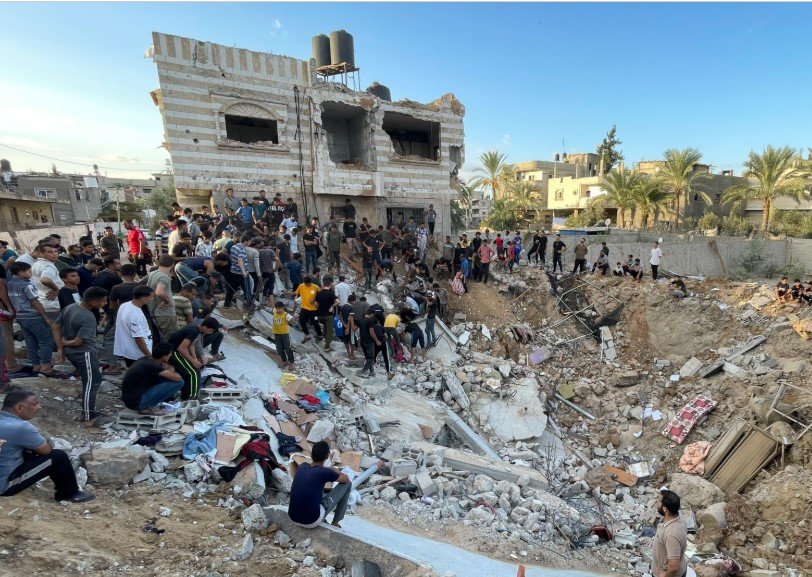Prime Minister Benjamin Netanyahu’s government doubled down on pre-emptive defense this week, with the Israeli military claiming it struck two F-14 fighter jets at an airbase in Tehran. The operation, detailed in a video released by the Israel Defense Forces (IDF), is being framed as a direct response to a growing drone threat from Iranian soil.
Smoke had barely cleared above southwest Tehran on Monday when the Islamic Republic of Iran Broadcasting (IRIB) building went dark mid-broadcast — a rare moment that amplified tensions across the region. The attack marks another sharp escalation in the Iran-Israel conflict, following weeks of warnings and retaliatory actions.
Tehran Hit Before Launch, IDF Claims
The Israeli military says it didn’t wait for an attack to happen. Instead, it acted on live intelligence showing Iranian forces setting up UAV launchers.
In an official update, the IDF stated: “Strike on two F-14 fighter jets that were located at an airport in Tehran. These jets were intended to intercept Israeli aircraft.”
Another part of the mission, according to the statement, targeted a launch cell preparing for a drone attack.
This wasn’t just about hitting hardware.
Officials believe the drones were meant to strike “critical sites inside Israel” and may have been timed to coincide with broader cyber or militant activity. But those plans, they say, were neutralized within minutes.

What the Footage Shows, and What It Doesn’t
The video, released late Monday night, shows what appears to be precision-guided munitions homing in on parked aircraft in a darkened airfield.
There’s no audio, just grainy visuals with thermal signatures and flashes. The location is tagged as a military zone near Tehran’s Mehrabad Airport.
Iranian state TV, IRIB, went off air around the same time due to damage sustained during the attack, adding to the confusion.
There’s no independent verification yet from Iranian authorities about the F-14s, though footage of smoke columns from central Tehran has been widely shared.
That alone has added fuel to speculation.
Stakes Rising Across the Region
Monday’s incident wasn’t a one-off. It’s part of a string of military operations, tit-for-tat drone activity, and threats bouncing across the Middle East since April.
The April 22 Pahalgam attack in India — allegedly backed by proxy groups — was followed by India’s Operation Sindoor, which in turn set the region on edge. Israel and Iran’s conflict has now slid into that same crossfire.
A senior Israeli defense analyst, speaking anonymously, noted: “The idea here is to strike first and publicly, and in a way that hurts Iran’s military morale.”
Meanwhile, a U.S. State Department spokesperson said they were “monitoring the situation closely” and reiterated the need for restraint from all sides.
Drone Warfare Takes Center Stage
The strike on the launch cell might sound surgical, but the drone game isn’t new for either side. Iran has expanded its UAV capabilities significantly in the past five years, and Israel’s anti-drone radar nets have also grown stronger.
Here’s a look at some of the recent drone-related incidents involving Iran:
-
March 2025: Iran-backed Houthis claimed a drone strike near Eilat, southern Israel.
-
May 2025: An Israeli oil facility in Haifa was temporarily shut due to suspected Iranian drone surveillance.
-
June 2025: Monday’s thwarted drone launch in Tehran.
It’s no longer shadow war — it’s a buzzing battlefield in the sky.
A Look at the Aircraft Involved
The mention of F-14s in 2025 raised more than a few eyebrows. Iran is the only country still operating the now-vintage American-made fighter jets, originally sold before the 1979 revolution.
According to data from GlobalSecurity.org, Iran is believed to have under 15 airworthy F-14s remaining, and even fewer are flight-ready at any time.
| Fighter Jet Model | In Service (Iran Estimate) | Operational Status |
|---|---|---|
| F-14 Tomcat | 11–14 | 5–7 airworthy |
| Su-24 Fencer | 20+ | 12–15 operational |
| MiG-29 Fulcrum | 25+ | 18–20 in rotation |
These jets, while outdated, still pose a threat when combined with Iran’s integrated missile systems. Which is exactly why Israel targeted them, experts say.
Public Response and Iranian Silence
There’s been little official noise from Tehran.
No press briefings. No TV statements. No live images from the airbase.
Locals in Tehran shared shaky mobile videos of explosions, some with audible screams, others just static after the blast. Social media in Iran was briefly throttled, though it’s unclear if that was linked to the strike or a separate blackout.
Meanwhile, protests flared up briefly outside the damaged IRIB building — likely more about government censorship than the Israeli attack.
One Iranian student, posting anonymously on X (formerly Twitter), wrote: “Even war has more truth than our state news. We don’t even know who got hit.”
Bigger Picture: Are More Strikes Coming?
The IDF’s decision to publish details publicly suggests a broader strategy — not just deterrence, but control of the narrative.
Analysts believe Israel’s posture has shifted from reactive to open, timed strikes. This includes not just Tehran, but Syria, Lebanon, and even cyber fronts.
There are murmurs that more Iranian installations are now under surveillance, including in Isfahan and Bandar Abbas.
That said, nobody’s betting on all-out war.
But whispers in diplomatic corridors say this isn’t over. Not even close.
